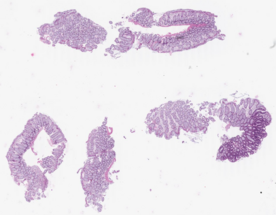Colorectal adenoma
Colorectal adenoma (adenomatous polyp) is the most common benign tumor polyp of the colon. Colorectal adenoma is a premalignancy in the narrower sense, the risk of relapse depends on the specific histological type.
Histological types[edit | edit source]
There are three types of adenomas according to the histological structure
- tubular adenoma,
- villous adenoma,
- tubulovillous adenoma.
Tubular adenoma[edit | edit source]
Macroscopically, tubular adenomas are smaller, pedunculated, often spherical, and can be flat. Histologically, it consists of irregularly arranged epithelial tubules. To diagnose a tubular polyp, dysplastic tubular structures must make up at least 80% of the tumor.
Villous adenoma[edit | edit source]
Macroscopically, villous adenoma tends to be larger, broadly sessile, and its surface is described as velvety or hair-like. Microscopically, it consists of thin finger-like to villous processes with only a fine stroma covered by epithelium. For the diagnosis of a villous polyp, dysplastic villous structures must make up at least 80% of the tumor.
Tubulovillous adenoma[edit | edit source]
Tubulovillous adenoma is a combination of both previous types from the macroscopic and microscopic point of view. A tubulovillous adenoma is an adenoma that has features corresponding to both tubular and villous adenoma but does not fulfil the criteria for either type of adenoma.
The clinical presentation[edit | edit source]
The risk of malignant transformation[edit | edit source]
The risk of malignancy depends on the histological type:
- Villous adenoma has the highest risk of malignant transformation. It is estimated that up to 50% of all villous adenomas would transform into colorectal cancer.
- Tubulovillous adenoma has a lower risk of malignant transformation, with approximately 20% of all tubulovillous adenomas expected to transform into colorectal cancer.
- Tubular adenoma has the lowest risk of malignant relapse, with only about 5% of all tubular adenomas expected to transform into colorectal cancer.
In addition to histological type, the degree of dysplasia is an important predictive factor of biological behavior.
The risk of malignant transformation is also affected by the size of the adenoma (polyp). Adenomas smaller than 10 mm rarely malign, regardless of type, whereas adenomas larger than 40 mm have a higher risk.
Links, virtual slide[edit | edit source]
Low grade, tubular adenoma H&E
http://www.pathowiki.org/jpView/$00D72FDA3C4/
https://www.pathowiki.org/pathowiki/index.php/Hauptseite
Related articles[edit | edit source]
Literature[edit | edit source]
- POVÝŠIL, Ctibor – ŠTEINER, Ivo. Speciální patologie. 2. edition. Praha : Galén, Karolinum, 2007. ISBN 978-80-7262-494-2 (Galén), 80-246-1442-7 (Karolinum).
- HAMILTON, Stanley R: – AALTONEN, Lauri A.. WHO Classification of Tumours : Pathology and Genetics of Tumours of the Digestive System [online] . 1. edition. Lyon : IARC Press, 2000. Available from <http://publications.iarc.fr>. ISBN 92-832-2410-8.

